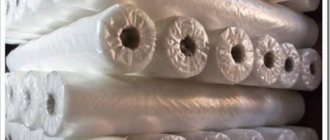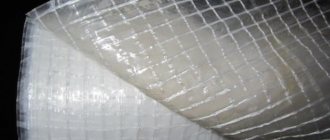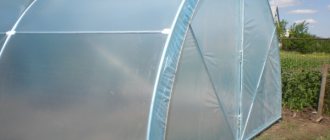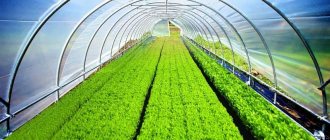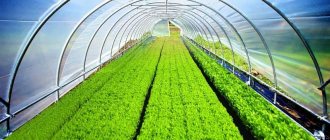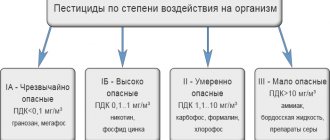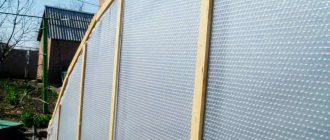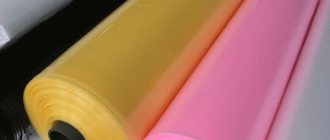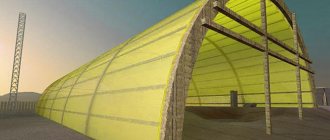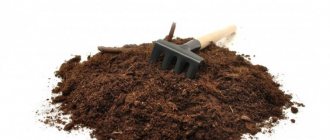Polyethylene film - what is it? Its properties and characteristics
Polyethylene film is a polymer material made from polyethylene granules and additives by extrusion.
The material has many advantages that determine its popularity:
- Resistance to chemical environments, inertness. Due to this quality, polyethylene is widely used in public catering;
- Extensibility and elasticity. Polyethylene fabric easily stretches and envelops the packaged item;
- Moisture and vapor tightness. The material is widely used in waterproofing during construction work, as a covering material, and in product packaging;
- Tightness - provides a barrier to air entry;
- Transparency (for unpainted films) – ensures good visibility of the product in film packaging;
- Good dielectric properties;
- Long service life.
Polyethylene films are easy to print (flexo printing, silk-screen printing, etc.).
The disadvantages include:
- Fear of high temperatures. At temperatures above 115 degrees, the film begins to melt;
- Sensitivity to UV rays. When exposed to them for a long time, polyethylene ages and begins to disintegrate, its strength characteristics deteriorate;
- Instability to low temperatures. When left in the cold for a long time, polyethylene becomes brittle.
Ways to Increase Durability
As noted, secondary films do not last as long as primary films.
Films will last longer if the following techniques are used in production:
- Light stabilization system . During extrusion, 0.2% of light stabilizers such as HAS and UV absorbers should be added. This technique will approximately double the life of the film. According to Basf, recycled film lasts approximately 57 days in the sun without loss of strength. Light stabilizers extend the service life to 117 days. This is quite enough for the season.
- An excellent synergist of light stabilizers is ordinary carbon black. Therefore, stabilized black films will last longer. But there is a nuance - when extruding film, it is better not to use black recyclables, since soot increases thermal degradation. Priority is given to light film waste, which can be dyed black with superconcentrate.
- The main raw material is secondary LDPE. By introducing HDPE regranulate in an amount of up to 30%, strength can be increased. If recyclable materials are difficult to recycle, it is recommended to add a little linear PE. Thus, using recycled granules to produce stretch film is a common process.
- Film material for different types of plants can be painted white, red, yellow. However, coloring the recycled material reduces its light and heat resistance.
Types of polyethylene films
Polyethylene film is manufactured in accordance with GOST 10354-82, heat-shrinkable fabric - in accordance with GOST 25951-83.
Polyethylene films are produced in different versions to suit the needs of various areas where they are used.
By composition
According to the composition of raw materials, polyethylene film can be made from:
- HDPE - low-density polyethylene;
- LDPE – high-density polyethylene.
Read how these types differ here.
Depending on the number of layers, PE films can be:
- single-layer;
- multilayer.
Various additives are added to polyethylene film to improve its properties. Based on the presence of additional “ingredients” in the composition, the canvas can be:
- Regular unstabilized - no additives;
- Light-stabilized - the added light stabilizer protects the material from exposure to direct sunlight, making it last several times longer;
- Hydrophilic (antifog ) - additives promote rapid drainage of condensate and rain from polyethylene, which prevents the formation of large droplets that cause burns to plants and reduce its light transmission;
- With the addition of antistatic agents , they repel particles of dirt and dust, which allows the film to remain clean and transparent all season long.
Depending on the production technology and composition, polyethylene films can be of different modifications:
- foamed;
- reinforced;
- black, black and white, color;
- from primary or secondary raw materials;
- heat shrink;
- technical;
- stretch films, etc.
By release form
Polyethylene film is manufactured in the following forms:
- canvas - a layer of film, without seams or folds;
- a sleeve is a polyethylene pipe wound into a roll. This can be a simple version of a sleeve or a sleeve with folds - folds on the sides;
- A half-sleeve is a sleeve cut on one side.
What is the difference between linen, sleeve and half-sleeve?
Dimensions of polyethylene films
The standard thickness of polyethylene films is from 20 to 200 microns. Depending on the purpose of the material, the density of the fabric is selected.
Polyethylene film is sold in rolls of 80-200 linear meters. Most often, products are sold in a 1.5 m wide sleeve, in a 3 m spread and in a winding of 100 linear meters. There are also widths of 6, 10 and 12 meters. Construction stores sell polyethylene hoses at retail in lengths of 1-10 meters. There are narrower or wider fabrics and sleeves, but these sizes are made to order by manufacturers.
Production technology
Stretch is produced using multilayer technology.
Despite all the seemingly complexity of the process, this allows for significant savings on raw materials and improves the quality characteristics of the film.
Three-layer packaging is considered standard.
But to enhance the strength characteristics, a five-layer structure is also possible .
Below we will consider the composition of each of the possible layers of this material and the properties of the individual components.
Application
Polyethylene films have a wide range of applications. It is used:
- In agriculture, as a covering material for greenhouses and greenhouses, for mulching the soil;
- In the food industry as packaging and packaging material, for group packaging of products on a pallet;
- In the construction industry to protect furniture and interiors during repairs, as hydro-, steam- and thermal insulation of premises, wind protection, storage of building materials;
- In production as packaging of household and industrial goods;
- As a basis for packaging and branded bags.
Raw Components
A simple three-layer technology is suitable for recycled material:
- External (outer layer). The main component in the production of stretch film is linear polyethylene. This is a kind of frame, it is responsible for strength. It is this that is replaced with the secondary one. The ideal option is to use PVD film regranulate. To increase strength, it is permissible to introduce secondary HDPE, but in very limited quantities. Due to the different structure, the polymers simply will not mix with each other and the material will tear.
- Inner layer . Polyethylene copolymers are used here. The most affordable option is a copolymer of ethylene and polypropylene, the so-called plastomer. It is responsible for the elasticity and “compressibility” of the film web. It is possible to replace plastomers in production with elastomers (copolymers of ethylene with butylene or octene), this will help correct the insufficient level of physicomechanics of raw materials from recycled LDPE. But such a move will lead to higher prices.
- The outer (bottom layer) is polyisobutylene. Essentially it is an adhesive base. In its pure form, it is a highly viscous liquid that is difficult to dose. There are polyisobutylene masterbatches from LDPE on the market in granular form, which are much more convenient to work with.
Price for polyethylene film
The cost of PE film depends on the composition of the feedstock. She may be:
- primary - made from primary polyethylene granules. The price of such material from manufacturers is 100-140 rubles per kg;
- secondary - with the addition of secondary granules or completely consisting of polyethylene waste. This material is more fragile and has a shorter service life compared to the first type. The cost of recycled polyethylene film varies from 70 to 110 rubles per kg.
When buying in bulk, manufacturers usually give discounts on their products.
When choosing polyethylene film, proceed from the required properties, dimensions, and application. Check with the manufacturer for the characteristics and quality of the material to choose the best option.
Useful videos
The production process of LDPE and HDPE film: How to glue film at home for a greenhouse, see: Features of choice for greenhouses, which one to choose: See how to cover a greenhouse with greenhouse film: What and how is air bubble film made from, its purpose and application: How to solder the film with your own hands - using a machine, a soldering iron and a regular iron, see: When making the right choice of rolled polyethylene film, we compare the quality and performance characteristics necessary for solving a specific problem, obtaining the optimal result in terms of price-quality ratio.
Necessary information? Save or share on social networks!
Polyethylene products
Types of PE
Polyethylene is made by enlarging ethylene hydrocarbon molecules. The polymerization process can take place under completely different conditions: temperature, pressure, and accompanying reactions of the substance give different polymer modifications with a wide range of characteristics:
- High pressure polyethylene (HDPE) has a low density, is one of the softest plastics and is used for the manufacture of more flexible and elastic products. Products from it are obtained with the smoothest and most shiny surfaces, having a high coefficient of transparency.
- Low pressure polyethylene (LDPE) is much denser and harder. It is used for the manufacture of the most durable products that can withstand heavy loads.
- Linear PE combines the strength of HDPE and the elasticity of LDPE, which is necessary in the production of a number of products and is especially used in the manufacture of films.
- Supermolecular polyethylene has unique properties of strength and resistance to various physical and chemical influences.
IMPORTANT! Contrary to beliefs about the impossibility of using polyethylene at high temperatures due to its thermoplasticity, some of its types are freely used for the manufacture of heating pipes and hot water supply. These are heat-resistant and so-called “cross-linked” (supermolecular) types of polyethylene, having a structure close to the crystal lattice of particularly hard substances
Types of products
The range of polyethylene products is striking in its breadth and “comprehensiveness”:
- Films for packaging, waterproofing, building greenhouses (glass replacement), making waterproof clothing (raincoats, gloves), etc.:
- Smooth,
- Bubble,
- Stretch,
- Heat shrinkable,
- Scotch.
- Containers for various purposes - from plastic bottles and food containers to canisters and tanks with a volume of up to 200 liters.
- Pressure or non-pressure pipes with a diameter from 10 to 1600 mm with different wall thicknesses:
- Plumbing,
- Gas,
- Sewer,
- Drainage,
- Heating.
- Dishes, both disposable and for longer use, as well as flower pots, etc.
- Children's and Christmas toys, souvenirs.
- Electrical insulating shells and plates.
- Anti-corrosion coatings for metal pipes, containers and other products.
- Shock absorbers for mechanical protection of objects during transportation, protection of pipelines buried in the ground from seasonal and seismic rock shifts, etc.
- Foamed materials for thermal insulation shells, substrates, gaskets in building construction, instrument and automotive industries.
- Housings for various instruments, apparatus, boats, etc.
- Engineering structures, landscaping items for house and children's playgrounds.
- Storage tanks for environmentally hazardous substances and waste disposal sites.
- Medical devices and prosthetic elements.
- Dry hot melt adhesive in the form of polyethylene powder.
Transportation
The film is transported by all types of transport in covered vehicles in accordance with the rules for the transportation of goods in force for this type of transport.
Film transportation by river transport is carried out in containers or bags in accordance with GOST 26663-85.
When transporting film rolls by rail, they are sent by carload in covered wagons or sent in universal containers in accordance with GOST 18477-79. Film rolls up to 1200 mm long inclusive are transported in packaged form. It is allowed, by agreement with the consumer, to transport film rolls in unpackaged form.
Packages are formed in accordance with GOST 26663-85 by mechanized or manual means on pallets in accordance with GOST 9078-84. The parameters and dimensions of the packages must comply with the requirements of GOST 24597-81, the maximum package size is 1240×1040×1350 mm, the gross weight of the package is no more than 1.25 tons, the means of fastening cargo in transport packages is in accordance with GOST 21650-76.
Classification options
LDPE film can be classified according to several criteria. The most important is the direction of further use:
- Packaging;
- Agricultural.
In turn, packaging film can be:
- Food;
- Industrial.
Shrink and stretch films can be divided into a separate category.
The shrink film has a thickness of 40-180 micrometers and a melting point of 120-200C. Under the influence of temperature, it changes shape, shrinking. At the junction, fairly strong sealed seams are obtained.
Stretch film is very thin and elastic. It stretches well, which reduces its consumption, but does not lose its properties. And thanks to the property of reverse stretching, it adheres tightly to the packaged product, emphasizing its shape, and reduces the volume of packaging to a minimum. The use of stretch film in several layers ensures almost 100% tightness of the packaging.
LDPE film can be purchased in various colors. The transparency of the film greatly depends on the thickness - the thinner, the more transparent. The thickened film used in construction has a white color characteristic of polyethylene. At the request of the end user, it is possible to obtain a film of any color by adding the desired dye during production.
LDPE film comes in the following forms:
- Canvas;
- Sleeve;
- Half sleeve
The half-sleeve and sleeve have one or two side seams and are very convenient for use in mass packaging of goods using packaging machines.
Safety
The film is not a toxic material. Its use under normal room or atmospheric conditions does not require any precautions.
When processing film at temperatures exceeding the melting point of polyethylene, the release of carbon monoxide, unsaturated hydrocarbons, organic acids, and aldehydes is possible.
Maximum permissible concentrations (MPC) of harmful vapors and gases of thermal oxidative destruction in the air of the working area of industrial premises must comply with the requirements of GOST 12.1.005-88 and must not exceed the standards approved by health authorities.
Polyethylene film
- a thin layer of material made of polyethylene.
Packaging polyethylene has such properties as elasticity, moisture resistance, frost resistance and hygiene. Polyethylene film is absolutely safe for human health [ source not specified 2330 days
]: it can even be used for the production of children's products.
Pros and cons when choosing cellophane
Cellophane bags are a very convenient packaging material. However, when choosing cellophane or polyethylene for daily use, you should know all the advantages and disadvantages of this type of packaging. After all, these two materials, similar in appearance but different in composition, have completely different properties. And, despite the fact that, due to the high cost and complexity of manufacturing, cellophane bags are much less common, preference in choosing packaging should still be given to them.
- Many factory-made sausage and cheese packages are made from cellophane. The structure of such a bag will always allow the contents to “breathe” and the food will remain fresh longer. For example, fresh bread will remain soft for 5 days.
- Cellophane, which is afraid of moisture, will not collect water released from food, as does polyethylene, which is unable to pass it through. Therefore, a plastic bag will always protect the product placed in it from excess moisture.
- In case of accidental contact with heating devices or fire, polyethylene instantly melts, while cellophane does not weld, but only shrinks.
- Cellophane is a safe material for both humans and the environment. Quickly decomposing naturally, such a bag does not emit harmful artificial substances, because is entirely biological material.
To be fair, it should be noted that in terms of the strength of the material, cellophane is slightly, but still inferior to plastic. If a polyethylene bag stretches under the weight, then the cellophane packaging, although very durable, will immediately “crawling at the seams” at the slightest tear. However, this small drawback cannot overshadow the positive aspects of cellophane. And its ability to keep food fresh for a long time, preventing it from becoming saturated with excess moisture, and the natural recycling of material without causing harm rightfully make the plastic bag the king of packaging.
https://youtube.com/watch?v=aRO60eOkZbo
